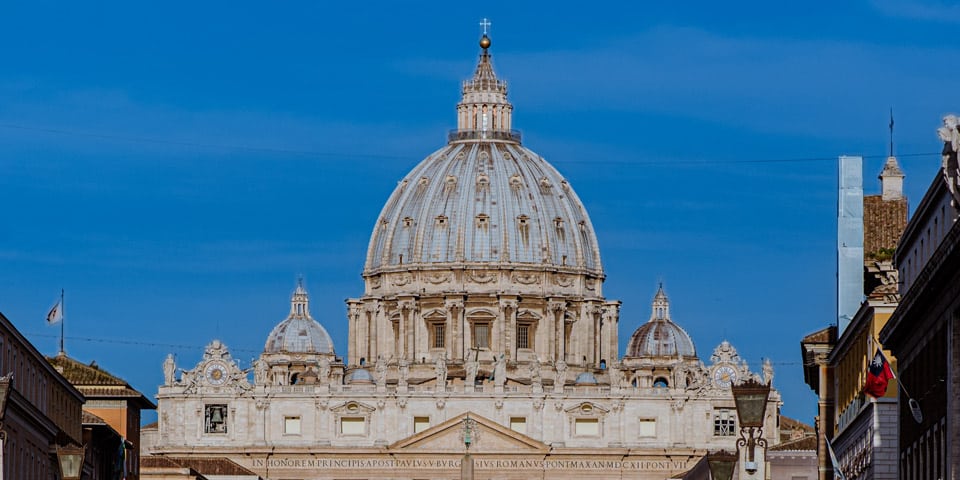

24858 views

| Tickets |
|
|---|---|
| Tip | Take a bottle of water with you. Large bags or purses are not allowed in the Basilica. There is a drop-off point for all bags in a room to the right of the church steps. |
| Opening Hours |
Monday:
-
Tuesday:
-
Wednesday:
-
Thursday:
-
Friday:
-
Saturday:
-
|
| Recommended tour | |
| Closest bus stops |
|
| Closest subway stations |
|
| Address | Piazza San Pietro, Città del Vaticano |
| Website | www.basilicasanpietro.va |
Climbing to the top of the cupola (dome) of St. Peter’s Basilica is a must-do attraction during your Roman holiday. The dome is the highest viewpoint in Rome, situated within the Vatican. From its observation deck, you can enjoy panoramic views of the city. To make the most of your visit, it’s best to arrive in the morning to enjoy the views without crowds and avoid long lines.
Contents
ToggleThe dome opens at 7:30 am, and you must pass a security check before starting your ascent. After the security check, look right for a sign directing you to the ticket kiosk for the dome. Payment is cash only.
On the way to the ticket desk, you will pass the entrance to the Basilica on the right side of the colonnade, followed by the Holy Door. Turn left to find the place to purchase tickets. After a 30-second elevator ride, you can stop for coffee or use the restroom at the dome.
The climb to the top involves progressively narrower and sloping stairs, which can be challenging for those with claustrophobia.
It can also be crowded and hot during summer. Fortunately, small windows offer fresh air and rest spots along the way.
Despite the difficulty, the climb is worth it for the spectacular views of Rome and the Vatican.
You can even send a postcard from the highest point of the Vatican. Postcards start at 50 cents, with stamps costing 2.30 euros for the US and 1 euro for Europe.
The souvenir shop sells themed postcards featuring the Vatican Museums, the Sistine Chapel, Popes, and the Swiss Guard.
The Great Dome is above the altar, and the Baldacchino is adorned with mosaic and stucco ornaments. Four structural piers, each with a perimeter of 71 meters and a height of 120 meters from the ground to the roof, support it. The dome features large inscriptions: “Hinc una fides mundo refulgent” (From here, a single faith shines throughout the world) and “Hinc sacerdotii unitas exoritur” (From here, the unity of the priesthood).
The dome is divided into sixteen ribs and segments, decorated with impressive figures, including:
There are 96 figures in total, set against a blue sky with stars.
Above them, the lantern bears a Latin inscription: “To the glory of St. Peter, Pope Sixtus V in the year 1590, the fifth of his pontificate.” Many artists contributed to the dome’s decorations after Michelangelo’s death, with Pope Clement VIII commissioning Giuseppe Cesari (Cavalier d’Arpino) to finish the upper part.
For a unique experience, consider a private tour to the Vatican at sunrise, which includes a climb up to the dome.
Michelangelo Buonarroti designed the dome of St. Peter’s Basilica, inspired by the domes of the Florence Duomo and the Pantheon, designed by Brunelleschi. Michelangelo envisioned a dome that combined classical beauty with innovative engineering. When he died in 1564, the new Basilica lacked the corner chapels, façade, and dome, with only the columns and drum completed.
In 1587, Giacomo della Porta, assisted by Domenico Fontana, took over the project. They faced the challenge of realizing Michelangelo’s vision while dealing with the structural constraints of the existing drum. Their modifications included a steeper curvature and an elongated lantern to enhance verticality. After two years, the dome was completed, standing as a testament to Renaissance ingenuity. According to legend, Michelangelo designed his dome 1.5 meters (5 feet) shorter than the Pantheon, stating, “I could build one bigger, but not more beautiful, than that of the Pantheon.”
The dome reaches a height of 133.3 meters from ground level, with an interior height of 117.57 meters and an inner diameter of 41.5 meters. The total weight is 14,000 tons. The double-shell design, with an inner and outer layer, provides both stability and aesthetic appeal. The inner shell is made of lightweight tufa, while the outer shell is composed of heavier travertine. This combination ensures the dome’s durability and reduces stress on the supporting structures.
Originally, the dome was intended to symbolize the heavens, encapsulating divine perfection through its harmonious proportions. Michelangelo’s plan called for a hemispherical dome similar to the Pantheon, but the final design was slightly more pointed to reduce lateral thrust on the supporting drum. The double-ribbed construction technique used in the dome’s design is a marvel of engineering, distributing the immense weight and allowing for the inclusion of large windows at the base of the dome, flooding the interior with natural light. These technical and aesthetic considerations make the dome of St. Peter’s Basilica an enduring icon of Renaissance architecture.
The following table lists notable domed structures around the world, sorted by their maximum inner height in meters. St. Peter’s Basilica holds the first place in terms of internal height, showcasing the architectural marvels of different eras and regions.
| # | Name of the Structure | Inner Height | Outer Height | Date of Construction | Diameter | City, Country |
|---|---|---|---|---|---|---|
| 1 | St. Peter's Basilica | 118 | 137 | 1506–1590 | 43 | Vatican City |
| 2 | Florence Cathedral | 115 | 117 | 1420–1436 | 38 | Florence, Italy |
| 3 | Basilica of Our Lady of Peace | 111 | 158 | 1985–1989 | 90 | Yamoussoukro, Ivory Coast |
| 4 | People's Salvation Cathedral | 106 | 135 | 2010–present | 29 | Bucharest, Romania |
| 5 | Rotunda of Mosta | 96 | 96 | 1833–1860 | 37 | Most, Malta |
| 6 | AT&T Stadium | 91 | 2005–2009 | Arlington, Texas, USA | ||
| 7 | Berlin Cathedral | 85 | 98 | 1894–1905 | 33 | Berlin, Germany |
| 8 | St. Paul's Cathedral | 65 | 111 | 1675–1710 | 31 | London, United Kingdom |
| 9 | Hagia Sophia | 56 | 56 | 532–537 | 31 | Istanbul, Turkey |
| 10 | United States Capitol | 55 | 88 | 1793–1866 | 29 | Washington, D.C., USA |
| 11 | Sultan Ahmed Mosque | 43 | 43 | 1609–1616 | 22 | Istanbul, Turkey |
| 12 | Florence Baptistery | 41 | 41 | 1059–1128 | 26 | Florence, Italy |
| 13 | Santa Maria di Loreto | 32 | 32 | 1507–1512 | 22 | Rome, Italy |
Author: Kate Zusmann
This website uses cookies. For more info read the cookies policy
Rome.us © 2025. Created with love by Roman experts and guides.